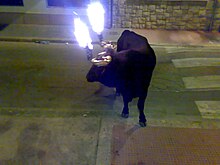
The festival of San Fermín is a week-long, historically rooted celebration held annually in the city of Pamplona, Navarre, Spain. The celebrations start at noon on 6 July and continue until midnight on 14 July. A firework (Chupinazo) starts off the celebrations and the popular song Pobre de mí is sung at the end. The most famous event is the running of the bulls, which begins at 8 a.m. each day on 7–14 July, but the festival involves many other traditional and folkloric events. It is known locally as Sanfermines in Spanish and Sanferminak in Basque, and is held in honour of Saint Fermin, the co-patron of Navarre.

A running of the bulls is an event that involves running in front of a small group of bulls, typically six but sometimes ten or more, that have been let loose on sectioned-off streets in a town, usually as part of a summertime festival. Particular breeds of cattle may be favored, such as the toro bravo in Spain, also often used in post-run bullfighting, and Camargue cattle in Occitan France, which are not fought. Bulls are typically used in such events.
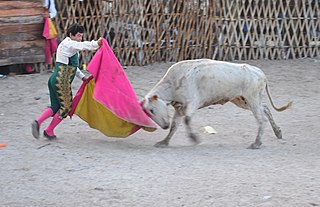
A bullfighter is a performer in the activity of bullfighting. Torero or toureiro, both from Latin taurarius, are the Spanish and Portuguese words for bullfighter, and describe all the performers in the activity of bullfighting as practised in Spain, Portugal, Mexico, Peru, France, Colombia, Ecuador, Venezuela and other countries influenced by Portuguese and Spanish culture. The main performer and leader of the entourage in a bullfight, and who finally kills the bull, is addressed as maestro (master), or with the formal title matador de toros. The other bullfighters in the entourage are called subalternos and their suits are embroidered in silver as opposed to the matador's gold. They include the picadores, rejoneadores, and banderilleros.

Bull-baiting is a blood sport involving pitting a bull against dogs with the aim of attacking and subduing the bull by biting and holding onto its nose or neck, which often resulted in the death of the bull.

Bull-leaping is a term for various types of non-violent bull fighting. Some are based on an ancient ritual from the Minoan civilization involving an acrobat leaping over the back of a charging bull. As a sport it survives in modern France, usually with cows rather than bulls, as course landaise; in Spain, with bulls, as recortes and in Tamil Nadu, India with bulls as Jallikattu.

Tordesillas is a town and municipality in the province of Valladolid, Castile and León, central Spain. It is located 25 kilometres (16 mi) southwest of the provincial capital, Valladolid at an elevation of 704 metres (2,310 ft). The population was c. 8,760 as of 2021.

Espinal is a Colombian municipality and town located in the Department of Tolima, 146 km southwest from Bogotá. It is the second most important town of the department and is the rice capital of the center of the country. It is flanked by the Magdalena and Coello rivers. El Espinal is known for the manufacture of typical musical instruments and its cuisine is known for tamales and the suckling pig, which are the typical dishes of the region. It has a total area of 231 km2, an urban area of 4.26 km2, and a rural area of 212.74 km2.

The Osborne bull is a black silhouetted image of a bull in semi-profile. Erected as either 14-meter-tall (46 ft) or seven-meter-tall (23 ft) billboards, as of July 2022 there are 92 of them installed on hilltops and along roadways throughout much of Spain.

The Spanish Fighting Bull is an Iberian heterogeneous cattle population. It is exclusively bred free-range on extensive estates in Spain, Portugal, France and Latin American countries where bull fighting is organized. Fighting bulls are selected primarily for a certain combination of aggression, energy, strength and stamina. In order to preserve their natural traits, during breeding the bulls rarely encounter humans, and if so, never encounter them on foot.
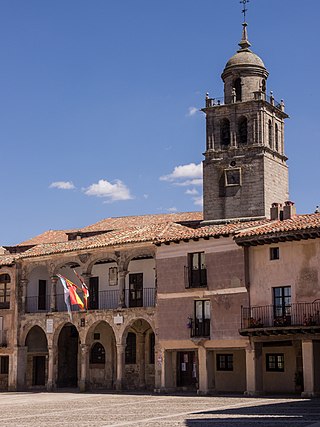
Medinaceli is a municipality and town in the province of Soria, in Castile and León, Spain. The municipality includes other villages like Torralba del Moral.

Spanish-style bullfighting is a type of bullfighting that is practiced in Spanish-speaking countries: Spain, Mexico, Colombia, Ecuador, Venezuela, Peru, as well as in parts of southern France and Portugal. This style of bullfighting involves a physical contest with humans attempting to publicly subdue, immobilize, or kill a bull. The most common bull used is the Spanish Fighting Bull, a type of cattle native to the Iberian Peninsula. This style of bullfighting is seen to be both a sport and performance art. The red colour of the cape is a matter of tradition – bulls are color blind. They attack moving objects; the brightly-colored cape is used to mask blood stains.

A toro de fuego is a festive activity in Spain, where a metal frame resembling a bull, with fireworks attached to it, is set alight, and then the person carrying the frame runs around town at night as if chasing people in the streets. Participants dodge the bull when it comes close, especially because the burning fireworks set off sparks that can cause small burns in people's skin or clothes. This activity is held in a number of Spanish towns during their local festivals. This custom may have originated to replace the Toro embolado, in which a real bull is involved.

The Running of the Nudes, like the well-known Running of the Bulls, takes place in Pamplona, Spain. The Running of the Nudes occurs two days before the Running of the Bulls, just before the start of the nine-day festival of San Fermín. The event was created in 2002 and is supported by animal welfare groups, including PETA, who object to the Running of the Bulls, claiming that the event is cruel and glorifies bullfighting, which the groups oppose. In the Running of the Nudes, naked humans, many wearing only plastic horns and red scarves, follow the same route taken by the Running of the Bulls from the Santo Domingo corrals through the town’s streets and ending at the Plaza de Toros. The length of the run is some 800 metres and the event takes about one hour.

The course landaise is an ancient form of bullfighting and bull-leaping held in oval or rectangular arenas covered in sand, that involves no bloodshed. Experienced cows, with large horns, aged generally from 2 to 14 years old, are used instead of bulls. They are athletic but small animals selected from the same breed as the bulls used for the Spanish corridas. In Gascony, it is a major spectator sport, counting as many as 600 events each year.
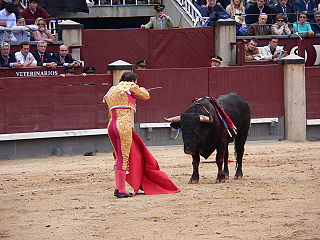
Bullfighting is a physical contest that involves a bullfighter attempting to subdue, immobilize, or kill a bull, usually according to a set of rules, guidelines, or cultural expectations.
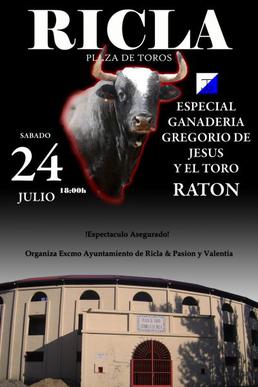
Ratón was a Spanish fighting bull that was nicknamed el toro asesino, el sangriento toro Raton and el terrible Ratón for killing three people in bullfighting rings in Spain during 2006–2011 and injuring thirty more. The bull became legendary in Spain due to the large number of gorings for which he was responsible. Bullfighting fans regarded him as a star and traveled from across the country to see the morlaco at his home at Sueca near Valencia. Matador Jesús Esteve said of Ratón: "He is a killer. He is lazy, he doesn't want to participate. He does his own thing, waiting for somebody to make a mistake. And then when he gets you, he wallops you, and he doesn't let up."
Mattu Pongal is the third day of the four-day Pongal festival. According to the Gregorian calendar it is celebrated on 16 January. Though the name of the festival is specific to Tamil Nadu, it is also celebrated in other southern Indian states such as Andhra Pradesh and Karnataka. Makar Sankranti is a festival that marks the start of northern declination of the Sun from the Zodiac sign of Sagittarius to Capricorn, which according to Tamil calendar usually falls on 14 January.
Bullfighting was banned in the Spanish autonomous community of Catalonia by a vote of the Catalan Parliament in July 2010. The ban came into effect on 1 January 2012. The last bullfight in the region took place on 25 September 2011 at La Monumental. The ban was officially annulled for being unconstitutional by Spain's highest court on 5 October 2016. However, despite the overturning of the ban, no further bullfight had taken place in Catalonia as of July 2020.

A bull is an intact adult male of the species Bos taurus (cattle). More muscular and aggressive than the females of the same species, bulls have long been an important symbol in many religions, including for sacrifices. These animals play a significant role in beef ranching, dairy farming, and a variety of sporting and cultural activities, including bullfighting and bull riding.

The National Pyrotechnic Festival, which takes place in Mexico, is an annual event to promote the country's tradition of production and use of fireworks. It began as celebration in honor of John of God, the patron saint of fireworks makers, in the municipality of Tultepec, State of Mexico, which produces about three quarters of all Mexico’s fireworks. The main event, a parade of toritos—or bull-shaped frames with fireworks attached to them—began in the mid 19th century. The modern national festival began in 1989 and consists of various events, including fireworks competitions. However, the main event remains that of the toritos; about 250 of which were paraded along the streets of Tultepec during the 2013 festival.
